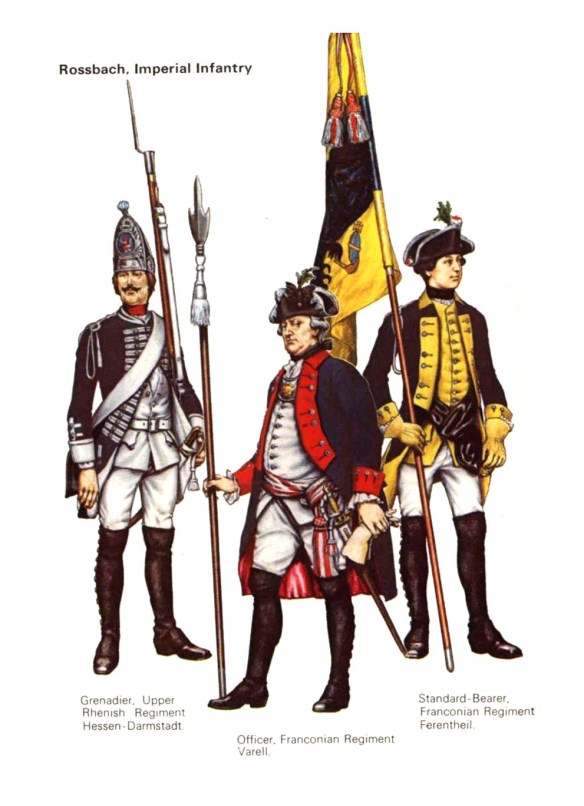At the beginning of February 1763, the Reichstag formally ended the Reichskrieg and declared the Reich to be neutral, which the Prussian representative Erich Christoph von Plotho declared Prussia would respect. This ended a long period of growing ambivalence and uncertainty. The liberation of Saxony remained the Reichstag’s only war aim. Increasingly, as other powers developed wider war aims, many German princes began to question their participation in the conflict. They had no interest in becoming mere auxiliaries in an Austro-Russian war to dismember Prussia or in a British war against France.
For some, the Battle of Rossbach (5 November 1757) marked the turning point, since the Reichsarmee was caught up in a battle against France that had little to do with rescuing Saxony. Bavaria and the Palatinate withdrew their troops in the following spring. Others became concerned at the way in which the conflict seemed to be turning into a religious war, with Protestant princes particularly perplexed at finding themselves on the `wrong’ side.
The Reichsarmee itself was nowhere near as ineffective as nationalist tradition held, though it was admittedly never large enough to operate as an independent force. The main losers at Rossbach were the French, whose 24,000 men were joined by only 11,000 Germans, of whom nearly 4,000 were Austrians. In subsequent battles, Reich troops were also dependent on an Austrian main force and prospered or suffered accordingly. Their last engagement was a severe defeat at the hands of Prince Henry of Prussia at Freiberg on 29 October 1762. By then, the Reichsarmee had dwindled from its initial notional strength of just over 32,000 to some 16,000. Following the Austro-Prussian truce in November, they were the last troops in the field, deserted by both France and Austria. The Reichstag’s decision to end its war was inevitable; the emperor ordered the disbanding of the imperial army on 24 February.
The existence of the Reichsarmee throughout the conflict probably made little difference in military terms. It did, however, serve as a physical reminder of the interests of the Reich, as distinct from both Austria and Prussia. That it remained in existence continuously was above all the achievement of the princes’ representatives at the Reichstag itself, who argued again and again for its renewal. Not for the first time, this much underestimated assembly of ambassadors demonstrated that it had developed an esprit de corps and a sense of identification with the interests of the Reich that helped individual representatives hold many a wavering prince to a consistent line. Indeed, though it was not represented at the peace talks, the Reich alone among all participants in the war achieved its war aims: the restitution of Saxony and the status quo in the Reich. That outcome reflected the way that the majority of German princes and their representatives at Regensburg had ignored the blandishments of both of the major German combatants.
Each side invested heavily in war propaganda. In 1756, Frederick attempted to claim that this was a religious war unleashed by Catholic Austria and Catholic France against Protestants in the Reich, and that Vienna aspired to transform the Reich into a hereditary Habsburg monarchy. Prussian propaganda variously sought to present Frederick as the injured party, as the defender of German liberty, as the guardian of all German Protestants, and as someone seeking to defend the Reich against Catholic oppression and Habsburg tyranny. The Austrian alliance with Germany’s perpetual enemy, France, was also emphasized, though Prussia was scarcely in a position to moralize on that score. Vienna reciprocated with the claim that Frederick was attempting to unleash a Protestant onslaught on the Catholics in the Reich and that his aim was ultimately secession from it.
Behind the propaganda lay more simple realities. Frederick intended to retain Silesia and possibly gain other territory. Indeed, throughout the war Frederick formulated a series of plans that would have secularized the north German bishoprics and divided them between Prussia and Hanover. Austria intended to regain Silesia and smash Prussia. The papacy in vain encouraged Vienna to think of the war as an opportunity to re-Catholicize the Reich. In 1764, however, a report prepared in Vienna reviewed the struggle of the period since 1740 as `a test of the strength of the Protestant nation against the Catholic nation’.
Claim and counter-claim inflamed passions at a time when confessional tensions ran high at the Reichstag over other problems. At root, however, the Reichstag was under no illusions. An attempt to turn a debate about a planned peace conference in Augsburg in 1761 into a religious issue failed when even some representatives of Protestant princes voted with Saxony, which argued that this was simply not the kind of issue on which the itio in partes principle had to be applied. That the congress never took place at all was due to the prevarication and lack of commitment of the major foreign powers, some of whom still hoped for a major military victory that would put them in a strong bargaining position. The true nature of the conflict in the Reich was clear to most at the Reichstag. Silesia was of no more concern to that body now than it had been in 1740. Almost all feared the restless and unpredictable aggression of the expansionist Prussia monarch. The Habsburg emperors had, after all, been contained on many occasions; for holding the emperor in check was a well-practised tradition of the Reich.
The persistence of the Reichsarmee and the consistency of Reichstag policy also formed a counterpoint to another remarkable manifestation of the conflict. The Prussian king’s audacity, his occasionally inspired military leadership, and his sheer dogged determination to survive against overwhelming odds turned him into a hero. In Prussia itself, support for Frederick II was extraordinary, and the King rapidly achieved a degree of personal popularity never experienced by any predecessor.
